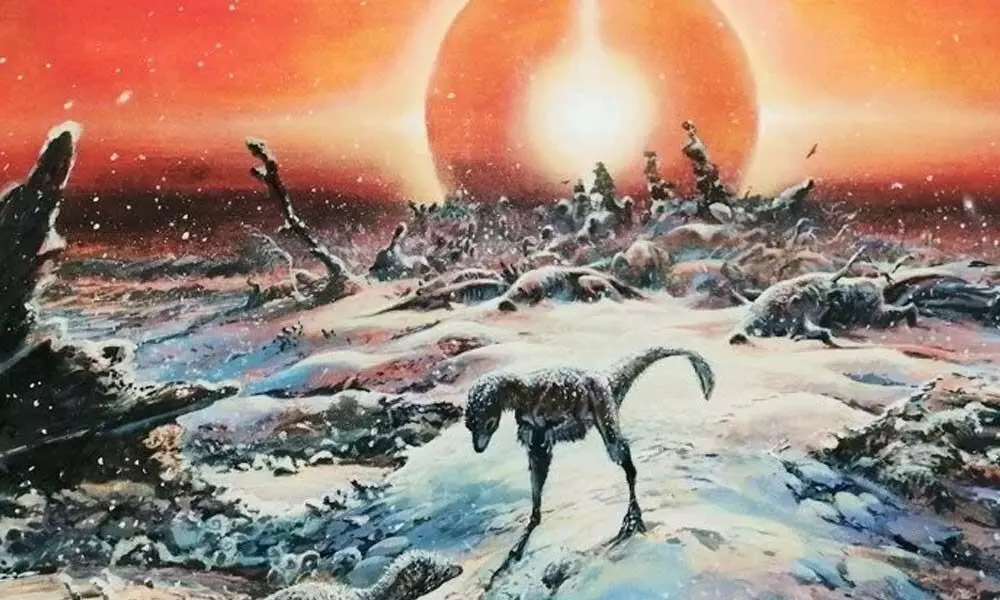Live
- Almonds are a key to faster muscle recovery after exercise: Study
- No govt faced so much criticism than Revanth-led Cong in 11 months: Kavitha
- Balineni signed SECI agreement, says Chevireddy
- Infant kidnapped from Niloufer Hospital rescued, cops arrest 3
- Sunny Leone reflects on challenges and preparations for ‘Shero’
- Hyderabad Saree Festival 2024 kicks off in a grand manner
- Speed up Veligonda project works, CPM urges govt
- 10 career opportunities with a public policy degree
- TG Medical Council cracks whip on fake doctors
- TTD takes up mammoth waste management exercise
Just In
Study Shows The Unimaginable Terrible Effects Of Dinosaur-Killing Asteroid


A T. rex chick shivers in the cold (© James McKay/Creative Commons)
- This massive cloud of sulfur-bearing gases, once airborne, blocked the Sun and cooled Earth for many years to centuries before falling as dangerous acid precipitation
- The fact that sulphur continued to rain down on Earth's surface for so long that explained why life, particularly marine life, took so long to recover
A new study indicates that when the dinosaur-killing asteroid struck with Earth 66 million years ago, vast amounts of sulphur were hurled into the stratosphere that were far terrible than previously imagined.
The massive cloud of sulfur-bearing gases, once airborne, blocked the Sun and cooled Earth for many years to centuries before falling as dangerous acid precipitation and altering the chemistry of the oceans for tens of thousands of years.
According to study co-researcher James Witts, a lecturer at the School of Earth Sciences at the University of Bristol in the United Kingdom. The fact that sulphur continued to rain down on Earth's surface for so long that explained why life, particularly marine life, took so long to recover, because some of the sulphur that landed on land would have washed away into the oceans.
The question that arose was what exactly happened when the asteroid that killed the dinosaurs smashed into Earth?
The researchers' discovery was purely coincidental. The researchers had intended to research the geochemistry of ancient shells near the Brazos in Falls County, Texas a singular location that was submerged during the end-Cretaceous extinction, when non-avian dinosaurs perished.
It's also not far from the Chicxulub crater in Mexico's Yucatan Peninsula, which was struck by a 6-mile-wide (10-kilometer) asteroid.The scientists took a couple of sediment samples at the location , something they hadn't intended on.
These samples were taken to the University of St Andrews in Scotland, where study co-author Aubrey Zerkle, a geochemist and geobiologist, studied the various sulphur isotopes, or sulphur variations with varied numbers of neutrons in their nuclei.
The researchers discovered a unique signal - the sulphur isotopes' masses showed very little fluctuations, according to Witts. When sulphur enters the atmosphere and interacts with ultraviolet (UV) light, mass changes occur.The Earth is around 4.5 billion years old, and an oxygenated atmosphere has engulfed it since about 2.3 billion years ago.
The Yucatan Peninsula's sulfur-rich limestone provided a huge portion of the sulphur. According to climate simulations, the sulphur aerosols entering Earth's atmosphere after the asteroid impact would have converted into sulphate aerosols, causing 3.6 to 14.4 degrees Fahrenheit cooling of the Earth's surface for a few decades following the impact.
However, because the sulphur content was larger, the climatic impact could have been even more catastrophic, according to the new findings.

© 2024 Hyderabad Media House Limited/The Hans India. All rights reserved. Powered by hocalwire.com






